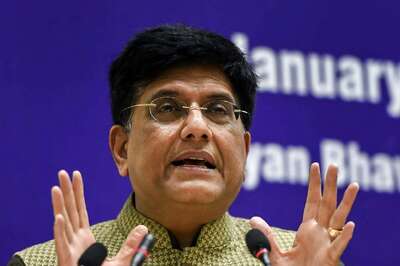
views
News published on July 11, World Population Day, gives India the dubious distinction of having the world’s largest population, by 2023. As a nation are we ready to deal with the emerging situation? My prognosis: we are poised to win but we must confront and surmount three tough challenges.
First, let us talk about what is favourable. A large population is not a calamity. While the Western world, Japan and China are enduring the longevity of too many old people, India can rest assured this will never happen here. Our share of the elderly will keep growing – but gradually – as both life expectancy and facilities for tertiary and quaternary care are improving. But there is no possibility that old people will depend on robots or be left destined to die alone at an old age home. In demographic terms, India does not suffer from an adverse dependency ratio which is a huge positive.
Caring for families is part of our cultural ethos. Most middle-class Indians living away from their parents, in the same city or elsewhere, maintain strong bonds with their families. Among the working class and rural poor, social cohesion is even stronger. My field study of Kusumpur Pahari – a huge 40-year-old slum located near our private colony in south Delhi revealed that grandfathers who came to the capital from villages in Bihar, Rajasthan, and Uttar Pradesh as youngsters, 30 years ago, to work as construction labour or rickshaw pullers, have returned to their village homes. Their children have received schooling in Delhi, continue to live in the same slum and every adult member, male or female, earns wages. Every guard, driver, domestic help, and even skilled people like electricians, plumbers, carpenters, masons, and welders told me that even after living for three generations in the Kusumpur Pahari slum, they visit their village homes regularly. Aged parents and siblings continue to receive remittances. This vignette gives confidence that despite urban migration, the elderly from the working class will never become a burden on society. Old age pensions have also helped.
The second good news is that fertility rates have fallen across the Indian states and that includes all communities and religions – despite alarming videos which foretell disaster. Fertility levels of all religious groups are converging extremely fast, and the problem of unwanted fertility is limited to identified districts mostly in Bihar, UP, and Jharkhand where the use of modern methods of contraception is less than 10% – among all communities. But given that the National Rural Health Mission has succeeded in ensuring safe institutional deliveries and adoption of family planning across the erstwhile BIMARU states, the laggard districts will catch up. For most poor women, the shackles of repeated childbirths and unsafe abortions stand severed.
The third positive news is that once the working-age population increases, opportunities for economic growth will explode. Our working-age population will boom for at least three decades more – making us the envy of the world. But for reaping the human resource harvest the population must be healthy and educated. And we are simply not doing enough.
Vast swathes of the population across socio-economic groups are increasingly suffering from diabetes, hypertension, and CVD. Prevention, not treatment, is the answer. Hospitalisation helps lakhs but prevention ensures freedom from disease for millions. Healthy populations are more productive, healthier children stay rooted in school, do not fall prey to childhood illnesses, and healthy people live longer with fewer hospitalisations. Governments have a responsibility to create conditions for staying healthy – not see healthcare through the narrow lens of hospital treatment. Needed are strong preventive health policies that address infant, child, and adolescent nutrition, and incentivise people to adopt healthy lifestyles and stay out of hospital.
On child-bearing, some uniquely Indian phenomena need to be flagged. Double-income Indian couples are increasingly choosing not to have children or to have only one child. The International Institute of Population Sciences refers to the “Child is King” syndrome – a demographic one-child transition which is real. China, once hailed for its one-child policy, now grapples in despair, its incentives to bear more children spurned by couples. In India, we have an additional problem – a strong son bias. While the sex ratio has improved, the child sex ratio is at unacceptable levels in Delhi, Haryana, Punjab, Telangana, Rajasthan, Maharashtra, Bihar, Odisha, Himachal Pradesh, and Tamil Nādu. The implications are a further decline in women’s labour force participation and increased crime and violence against women. Both can snatch away the gains of a youthful population.
Employability is essential to utilise a burgeoning youthful population productively. And education is fundamental to employability. Across the board, Covid has pushed back school and college learning by two years and its effect particularly on young children is presently unknown. Already, business promoters are advocating leapfrogging across traditional courses by replacing university education with non-academic, practitioner-run courses. But can the intangible gains from reading, peer learning, team spirit, and healthy competition be sacrificed to ride a tiger called technology? No. We need to first forecast future needs and then facilitate courses that have high employment potential to meet market demand. Unless the future manpower requirements are calculated sector by sector and the curriculum correlates with those needs, we may foster irrelevance and, in time, frustration.
Lastly, we must face water scarcity which is forcing citizens to take to the streets. Unless the decades-old focus on water-guzzling crops corrects, we may have abundant food to eat but no water to live. The National Institute of Hydrology had rung alarm bells about what has happened to the water situation in Punjab and Haryana, but no impactful changes are visible even after more than two years. A thirsty population, a dead river Yamuna, and water fights do not augur well for the vast populace of the northern states.
India has a windfall opportunity to scale mountains. But so much depends on our desire and capacity to see a healthy, educated population reach its true potential. Demonstrably, not rhetorically.
Shailaja Chandra is former Secretary, Health Ministry, and the first Executive Director of Jansankhya Sthirata Kosh (National Population Stabilisation Fund). The views expressed in this article are those of the author and do not represent the stand of this publication.
Read all the Latest News, Breaking News, watch Top Videos and Live TV here.



















Comments
0 comment